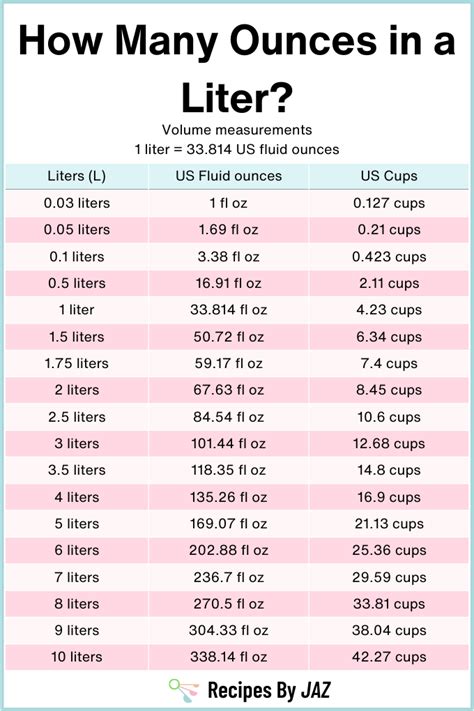How Many L Is 32 Oz
Kalali
Mar 21, 2025 · 4 min read

Table of Contents
How Many Liters is 32 oz? A Comprehensive Guide to Fluid Conversions
Understanding fluid measurements can be tricky, especially when dealing with different units like ounces and liters. This comprehensive guide will delve deep into the conversion of 32 fluid ounces (fl oz) to liters (L), clarifying the process and providing valuable context for various applications. We'll explore the conversion factor, address common misconceptions, and offer practical examples to solidify your understanding.
Understanding Fluid Ounces and Liters
Before diving into the conversion, let's briefly define our units of measurement:
-
Fluid Ounce (fl oz): A unit of volume in the imperial and United States customary systems. It's important to note that there are slight variations between the US fluid ounce and the imperial fluid ounce, although the difference is usually negligible in everyday conversions.
-
Liter (L): A unit of volume in the metric system. It's a fundamental unit widely used globally for various applications, from cooking to industrial processes.
The Conversion Factor: From Ounces to Liters
The key to converting 32 fl oz to liters is the conversion factor. One US fluid ounce is approximately equal to 0.02957 liters. This means that to convert fluid ounces to liters, you multiply the number of fluid ounces by this conversion factor.
Calculating 32 Fluid Ounces in Liters
Let's perform the calculation:
32 fl oz * 0.02957 L/fl oz ≈ 0.94624 Liters
Therefore, 32 fluid ounces is approximately equal to 0.946 liters. You'll often see this rounded to 0.95 liters for practical purposes.
Common Misconceptions and Precision
It's crucial to address some common misunderstandings regarding this conversion:
-
Precision: While our calculation gives us 0.94624 liters, this level of precision might not be necessary in many situations. Rounding to 0.95 liters is often perfectly acceptable, especially for everyday tasks like cooking or pouring liquids. However, in scientific or industrial settings, higher precision might be required.
-
US vs. Imperial Fluid Ounces: The conversion factor we used is based on the US fluid ounce. While the difference between US and imperial fluid ounces is relatively minor, using the incorrect factor will lead to a slightly inaccurate result. If you're working with imperial fluid ounces, you'll need a slightly different conversion factor (approximately 0.02841 liters per imperial fluid ounce).
Practical Applications: Where This Conversion is Useful
Understanding the conversion between fluid ounces and liters is vital in many different contexts:
1. Cooking and Baking
Many recipes, especially those from the US, might list ingredients in fluid ounces. If you're using a metric measuring system, you'll need to convert these measurements to liters or milliliters for accuracy. Knowing that 32 fl oz is roughly 0.95 L can help you accurately measure ingredients.
2. Medicine and Healthcare
Dosages of liquid medications are sometimes given in fluid ounces. Healthcare professionals and patients might need to convert these dosages to liters or milliliters for precision in administration. Accurate conversion is paramount in this field.
3. Industrial Processes
Many industrial processes involve the handling of liquids, and understanding conversions between different units is critical for ensuring accuracy and efficiency. This applies to manufacturing, chemical processing, and other industries.
4. Travel and International Trade
When traveling internationally or engaging in international trade, being familiar with different units of measurement is extremely important to avoid confusion and potential errors. Understanding volume conversions is especially important for liquids, ensuring consistency across borders.
5. Scientific Experiments
Scientific experiments often involve precise measurements. Knowing the exact conversion between fluid ounces and liters is critical for replicating experiments accurately and interpreting results effectively.
Beyond 32 Fluid Ounces: Mastering the Conversion
The principle behind converting 32 fluid ounces to liters applies to other volumes as well. Simply multiply the number of fluid ounces by the conversion factor (0.02957 L/fl oz for US fluid ounces) to find the equivalent in liters.
For example:
- 16 fl oz: 16 fl oz * 0.02957 L/fl oz ≈ 0.473 L
- 64 fl oz: 64 fl oz * 0.02957 L/fl oz ≈ 1.892 L
- 128 fl oz (1 gallon): 128 fl oz * 0.02957 L/fl oz ≈ 3.785 L
Using Online Conversion Tools
While understanding the underlying calculation is valuable, online conversion tools can simplify the process. Numerous websites and apps provide instant conversion between fluid ounces and liters, offering a quick and easy way to verify your calculations or perform conversions for different volumes. However, always double-check the results, especially if dealing with high precision.
Conclusion: Fluid Measurement Mastery
Mastering fluid conversions, such as converting 32 fluid ounces to liters, is an essential skill in many areas of life. This guide has provided a thorough understanding of the conversion process, common misconceptions, and practical applications. Whether you're cooking, conducting scientific experiments, or engaged in international trade, the ability to confidently convert between fluid ounces and liters ensures accuracy and efficiency. Remember to always clarify whether you are using US or Imperial fluid ounces to ensure precise calculations.
Latest Posts
Latest Posts
-
How Big Is 54 Inches In Feet
Mar 28, 2025
-
How Hot Is 100 Degrees Celsius
Mar 28, 2025
-
165 Centimeters Is How Many Inches
Mar 28, 2025
-
How Many Grams Is 40 Oz
Mar 28, 2025
-
How Many Grams In 1 4 Ounce
Mar 28, 2025
Related Post
Thank you for visiting our website which covers about How Many L Is 32 Oz . We hope the information provided has been useful to you. Feel free to contact us if you have any questions or need further assistance. See you next time and don't miss to bookmark.
